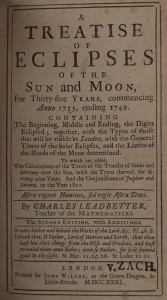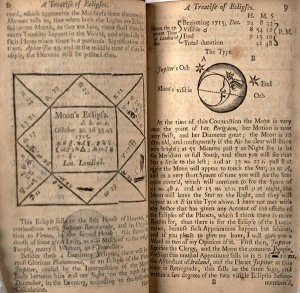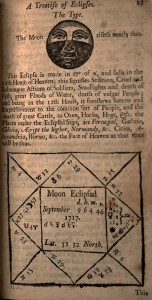This article is written by Heather Anderson, Special Collections Assistant.
Charles Leadbetter. A treatise of eclipses of the sun and moon: for thirty-five years, commencing anno 1715, ending 1749. London: printed for John Wilcox, at the Green-Dragon, in Little-Britain, MDCCXXXI [1731]
Foyle Special Collections Rare books collection QB542.L3 LEA
 Earlier this year, the Foyle Special Collections Library acquired a copy of A treatise of eclipses of the sun and moon, by Charles Leadbetter (1681–1744), a work which records and predicts solar and lunar eclipses and includes accompanying astrological predictions.
Earlier this year, the Foyle Special Collections Library acquired a copy of A treatise of eclipses of the sun and moon, by Charles Leadbetter (1681–1744), a work which records and predicts solar and lunar eclipses and includes accompanying astrological predictions.
As well as being a work of great interest relating to astronomy, mathematics and astrology, this publication also contains attractive woodcut illustrations throughout. I had the opportunity to catalogue this publication, which gave me the chance to learn a bit about the work and its author, and allowed me to gain experience of cataloguing a rare book.
Charles Leadbetter
Charles Leadbetter was an English astronomer and mathematician. Originally from Lancashire, Leadbetter worked for the local Excise Office until 1713, before moving to London in 1715, where he wrote and edited works on positional astronomy and on forms of measurement, such as gauging.
From his establishment at the Hand and Pen in Cock Lane, Shoreditch, he also taught a number of subjects and offered measuring services, as we can see in an advertisement for his business printed in our copy of A treatise of eclipses, which reads:
Arts and Sciences, Mathematical; proffered and taught by the author hereof, at the Hand and Pen, in Cock-Lane, near Shore-Ditch, London: viz. vulgar and decimal arithmetick, trigonometry, astronomy, surveying, gauging, dialling and navigating: Who also performs all sorts of measuring, either for master or workman, with care and expedition, at reasonable rates.
Leadbetter was described in his obituary in the Penny London post as ‘greatly esteem’d for his comprehensive knowledge in the Mathematical Sciences’.
A treatise of eclipses of the sun and moon
 In this work Leadbetter records and predicts eclipses occurring from 1715 to 1749, and also includes forecasts for the transits of Venus and Mercury over the sun and the conjunctions of Jupiter and Saturn up to 1821. The copy held in the Foyle Special Collections Library is an enlarged edition of the 1717 first edition.
In this work Leadbetter records and predicts eclipses occurring from 1715 to 1749, and also includes forecasts for the transits of Venus and Mercury over the sun and the conjunctions of Jupiter and Saturn up to 1821. The copy held in the Foyle Special Collections Library is an enlarged edition of the 1717 first edition.
In his introduction, addressed ‘To the sons of Urania’ (Urania being the muse of astronomy in Greek mythology), Leadbetter indicates that his text is aimed at the general reader with an interest in astronomy: ‘my only aim in this treatise is to instruct the ignorant who either loves or desires to be taught the knowledge of these things”.
The majority of the work is then dedicated to comprehensively recording and predicting all solar and lunar eclipses that will occur from 1715 to 1749. Leadbetter forecasts the number of eclipses that will occur each year, specifying the type of eclipse and the date and time of its occurrence. He also notes if and how it will appear to observers in London and includes calculations, showing the reader how he came to his conclusions.
Many of the eclipses described are accompanied by a woodcut illustration. These illustrations show the degree to which the sun or moon will be eclipsed, along with visible stars and planets. Each woodcut, rather charmingly, has facial features, with facial expressions often varying for different lunar and solar representations.
The author also accompanies the most significant eclipses with astrological predictions. He outlines the consequences of certain eclipses and accompanies these prophecies with diagrams displaying the twelve astrological houses.
The majority of the astrological predictions in the book are catastrophic in nature. For example, the lunar eclipse of 9 September 1717:
This eclipse… falls in the 12th House of Heaven; this signifies sedition, cruel and inhumane actions of soldiers, sea-fights and death of fish, great floods of water, death of vulgar people; and being in the 12th House, it foreshews sorrow and imprisonment to the common sort of people….
The solar eclipse of 13 July 1721 is forecast to have similarly cataclysmic consequences:
It falls in the beginning of the regal sign Leo, and in the 11th House of Heaven, signifies the death of a mighty prince, violent mischiefs, cruelty and toil, a scarcity of corn and fruit; murders, thefts, abortions to women with child.
The eclipses, however, are occasionally an augury of more favourable circumstances, such as the partial lunar eclipse of 23 January 1730, which should bring ‘peace and plenty upon mankind in general, both by land and sea’.
Provenance
This copy of Leadbetter’s work page is stamped ‘v. Zach’ on the title page and has corrections throughout by a former owner. It is probable that the owner was German Hungarian astronomer Franz Xaver von Zach (1754-1832), a central figure in the discipline who lived in London from 1783 to 1786.
 This owner has corrected some calculations and misprints throughout the text and has also amended the dates of forecasts for Venus and Mercury passing over the sun from 1786-1799, which implies that he may have observed these planetary transits. Each of the dates added are only a few days following Leadbetter’s predictions.
This owner has corrected some calculations and misprints throughout the text and has also amended the dates of forecasts for Venus and Mercury passing over the sun from 1786-1799, which implies that he may have observed these planetary transits. Each of the dates added are only a few days following Leadbetter’s predictions.
The cataloguing process
Having recently been on a CILIP training day at Lambeth Palace that covered the use of DCRM(B) (Descriptive cataloguing of rare materials (books)), I was delighted to have the opportunity to put my learning into practice by cataloguing this newly acquired publication.
When cataloguing a rare book, creating a full description of the specific copy is important, as individual copies often have unique features. In the case of this book, recording evidence of the item’s provenance, which includes the owner’s book stamp and corrections throughout, is essential, as researchers may have an interest in the history of the book’s ownership.
Recording further details on the physical nature of the item, such as the woodcuts and the binding, was also important, as these details may be relevant to researchers interested in the book as a physical object. Ensuring significant printed elements of the book are transcribed as they appear on the page, such as the title page and imprint, and noting additional printed features such as advertisements and pagination was also necessary as these details can vary in other copies of an early printed work (even those of the same edition).
Cataloguing this publication was a great opportunity to look at a fascinating 18th century printed work in detail. The cataloguing process gave me the chance to consider how various aspects of a rare publication may be of interest to researchers, from the book’s subject matter to its physical and printed elements. Researchers are welcome to consult this work in the Foyle Special Collections Library.
Bibliography
DJ Bryden, ‘Leadbetter, Charles (1681–1744)’, Oxford Dictionary of National Biography, Oxford University Press, 2004; online edn, Jan 2008 [http://www.oxforddnb.com/view/article/16233, accessed 22 Sept 2017]
BS Capp. Astrology and the popular press: English almanacs 1500-1800. London: Faber, 1979
Encyclopaedia Britannica, ‘Franz Xaver von Zach’, [https://www.britannica.com/biography/Franz-Xaver-von-Zach, accessed 22 Sept 2017]

I have been after more information on Charles Leadbetter as he is an ancestor of mine – I am lead to believe ( via the “Leadbetter papers” ) that Captain Cook used his calculations to sail round the world, and more importantly come back again ! Anyone with further knowledge of this matter please contact me at davebassett@hotmail.co.uk
Thank you very much for your interest. We only have this item by Leadbetter in our collection and the ODNB was our main source of information, as we cite. Good luck with your research.